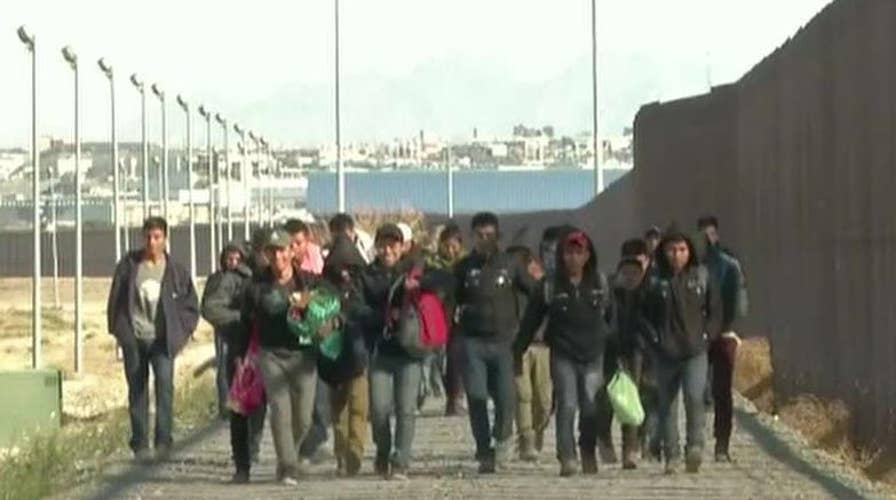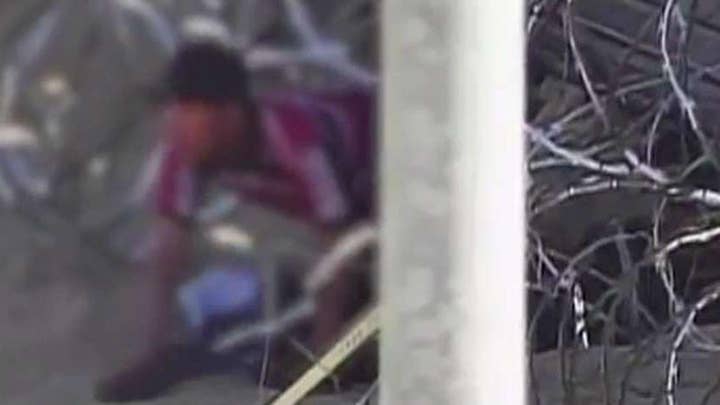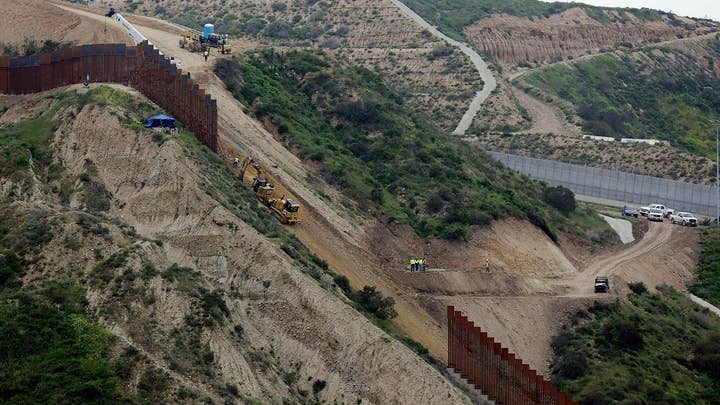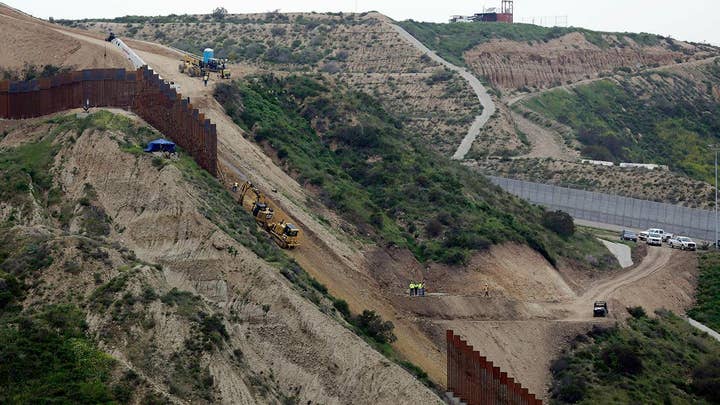US Border Patrol on track to apprehend about 1 million migrants in 2019
The U.S. Border Patrol reports a record 3,700 migrants were apprehended in one day in March; William La Jeunesse reports on the numbers.
Every day it seems that U.S. border patrol agents are encountering larger and larger groups of mostly Central American families and unaccompanied minors crossing the border from Mexico - straining already busy agents almost to the "breaking point."
Earlier this month, nearly 300 illegal immigrants were apprehended crossing the southern border in the Rio Grande Valley in Texas; this followed the apprehension of nearly 750 illegal immigrants days before in the Yuma sector in Arizona.
Just this weekend, agents in the Tucson Sector of Arizona encountered several large groups totaling nearly 400 people.
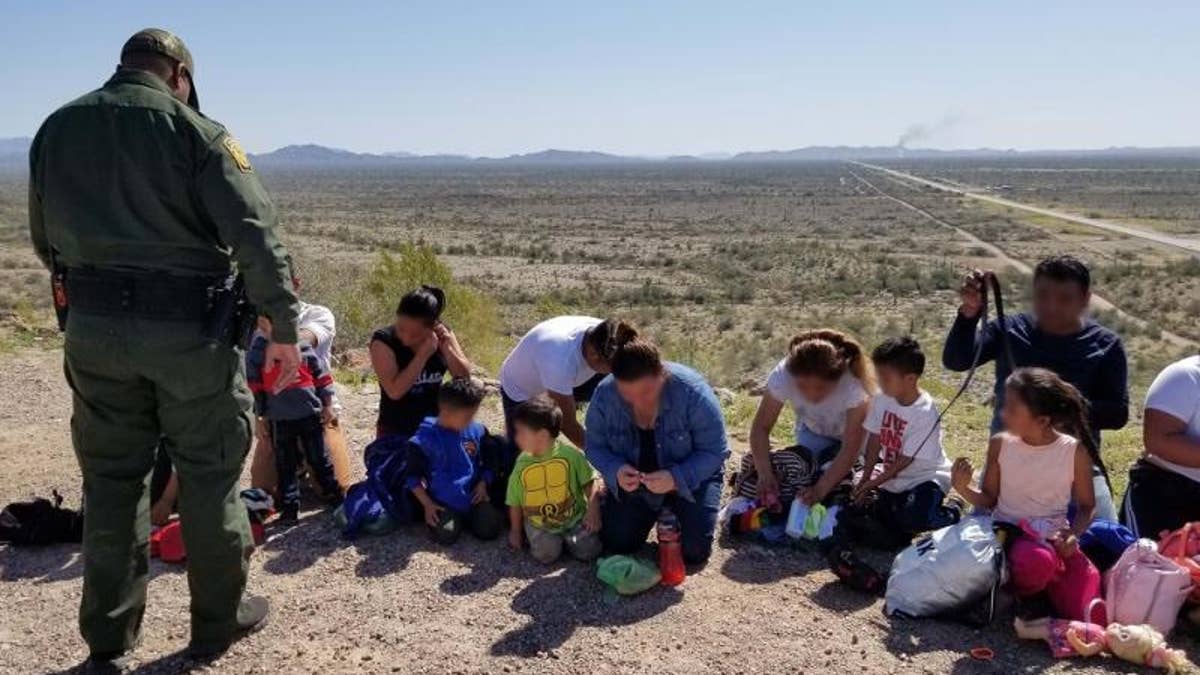
U.S border agents continue to see large number of illegal immigrant groups crossing the border. (U.S. Customs and Border Protection)
U.S. Customs and Border Protection in Arizona said the first group of 216 illegal immigrants was spotted Saturday morning by agents along a desolate road that parallels the international boundary fence west of Lukeville.
On Monday, another large group totaling 179 persons – mostly from Guatemala, Honduras, and El Salvador – were apprehended in the same area.
BORDER OFFICIALS GEARING UP FOR RECORD NUMBER OF MIGRANTS TRAVELING AS FAMILIES TRY TO ENTER US
The arrests come just days after Roy Villareal, the new chief in charge of most of Arizona’s international border with Mexico, said the arrival of migrant families in large groups is pushing the agency to a “breaking point.”
Villareal, who was previously the San Diego Sector deputy chief before moving to the Tucson Sector, said the agency is not prepared to deal and handle the arrival of such large numbers of families.
"When you look across the Southwest border, again looking at the system that's in place not being designed to handle this type of migratory flow, it's pushed us to a breaking point," he said, according to AZ Central. "We don't have adequate detention facilities."
SMUGGLER USES GIRLS AS DISTRACTION TO HELP 10 PEOPLE ILLEGALLY CROSS US-MEXICO BORDER, OFFICIALS SAY
Arizona remains one of the busiest drug and human trafficking areas along the U.S.-Mexico border, according to government statistics.
To date, in Fiscal Year 2019, the Tucson Sector in Arizona has seen a 237 percent increase in family unit apprehensions, while only a 1 percent decrease in unaccompanied minor detentions.
In the Yuma Sector of Arizona, agents have seen a 230 percent increase in family unit apprehensions and a 36 present increase in unaccompanied minors when compared to year-to-date numbers last year, CBP revealed earlier this month.
Across the border, 60 percent of apprehensions at the border are family units and unaccompanied minors, the agency said earlier this month. More than 268,000 family units and unaccompanied minors have been apprehended at the United States’ southern border to date in Fiscal Year 2019, CBP said.
PENTAGON AUTHORIZES UP TO $1B TO START 57 MILES OF BORDER WALL CONSTRUCTION
Jessica Vaughan, director of policy studies at the Center for Immigration Studies, told Fox News in an email Wednesday that the current phenomenon of large groups crossing is “a result of what is a near complete breakdown of border control.”
“The smugglers are so brazen now that they are chartering buses to pick up migrants in southern Mexico and bring them directly to the border area to file across and await discovery by the US Border Patrol, knowing that the migrants will be released in just a few hours to go wherever they want to go in the United States,” she said.
Vaughan added that because the Trump administration is not processing these cases for accelerated deportation or expediting their asylum claims, “these people probably are here to stay.”
“Now is the best possible time to come here illegally, as long as you bring a child,” she said. “We are at the point where the Trump administration needs to take relatively drastic action by leaning on Mexico to help shut down these motorized caravans and to process and send back the migrants who have arrived most recently. This will send a message that people can no longer get away with this.”
While the Grand Canyon State is one of the most fortified stretches along the U.S.-Mexico border, most of the fortifications are vehicle barriers which do little to stop people from walking across.
Yuma’s border chief, Anthony Porvaznik, told Fox News last week that smugglers are making the existing border obsolete because they dig and cut through the structures to “come right under it.”
The Trump administration has said the border is in a state of crisis, helping justify the president's decision to declare a national emergency last month and free up military funds to erect a border wall.
Late Monday, the Pentagon notified Congress that it authorized the transfer of up to $1 billion to erect 57 miles of “pedestrian fencing” along the southern border in direct support of Trump’s national emergency declaration.
The fencing, which will be 18 feet high, is to be erected in the Yuma and El Paso sectors, the statement read.
Democratic lawmakers fought back on Tuesday, with Armed Services Committee Chairman Adam Smith, D-Wash., saying in a statement that Congress had entrusted the Defense Department with the ability to redirect a limited amount of funds "to give them additional flexibility to manage day-to-day operations. DoD’s recent notification of its intent to use that process to reprogram $1 billion without Congressional approval is a violation of that trust."
CLICK HERE TO GET THE FOX NEWS APP
The Border Patrol operates 34 permanent checkpoints along the Mexican border — typically brick-and-mortar buildings with canopies over vehicle lanes — and another 103 "tactical" stops, often cones and signs that appear for brief periods, the Government Accountability Office said in a 2017 report.
While checkpoints account for only a sliver of Border Patrol arrests — 2 percent from 2013 to 2016 — they also handled 43 percent of drug busts during that time, according to the GAO.
Fox News' Edmund DeMarche and Samuel Chamberlain, and the Associated Press, contributed to this report.




















